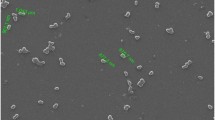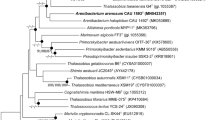Abstract
A Gram-stain-positive, aerobic, non-motile, coryneform bacterium, designated strain EGI 60002T, was isolated from the halophyte Suaeda physophora. Cells were coryneform shaped and polymorphic. Phylogenetic analysis based on 16S rRNA gene sequences showed that the new isolate was closely related to Actinotalea ferrariae CF5-4T (95.8 % gene sequence similarity). The peptidoglycan type of strain EGI 60002T was A4β, containing l-Orn-d-Ser-d-Asp. The cell-wall sugars were mannose, ribose, rhamnose and glucose. The major fatty acids (>5 %) of strain EGI 60002T were iso-C14:0, iso-C15:0, anteiso-C15:1 A and anteiso-C15:0. The predominant respiratory quinone was MK-10(H4). The major polar lipids were diphosphatidylglycerol (DPG), one unidentified phosphoglycolipid (PGL) and one unidentified phospholipid (PL1). The genomic DNA G+C content was 72.3 mol%. On the basis of morphological, physiological, chemotaxonomic data, and phylogenetic analysis, strain EGI 60002T should be classified as a novel species within the genus Actinotalea, for which the name Actinotalea suaedae sp. nov. is proposed. The type strain is EGI 60002T (=JCM 19624T = KACC 17839T = KCTC 29256T).


Similar content being viewed by others
References
Bagnara C, Toci R, Gaudin C, Belaich JP (1985) Isolation and characterization of a cellulolytic microorganism, Cellulomonas fermentans sp. nov. Int J Syst Bacteriol 35:502–507
Breznak JA, Costilow RN (1994) Physicochemical factors in growth. In: Murray RGE, Wood WA, Krieg NR, Gerhardt P (eds) Methods for general and molecular bacteriology. American Society for Microbiology, Washington, D.C., pp 137–154
Cappuccino JG, Sherman N (2002) Microbiology: a laboratory manual, 6th edn. Benjamin/Cummings, Menlo Park
Cerny G (1978) Studies on aminopeptidase for the distinction of Gram-negative from Gram-positive bacteria. Appl Microbiol Biotechnol 5:113–122
Chen F, Shi Z, Wang G (2012) Arenimonas metalli sp. nov., isolated from an iron mine. Int J Syst Evol Microbiol 62:1744–1749
Cowan ST, Steel KJ (1965) Manual for the identification of medical bacteria. Cambridge University Press, London
Felsenstein J (1981) Evolutionary trees from DNA sequences: a maximum likelihood approach. J Mol Evol 17:368–376
Felsenstein J (1985) Confidence limits on phylogenies: an approach using the bootstrap. Evolution 39:783–791
Fitch WM (1971) Toward defining the course of evolution: minimum change for a specific tree topology. Syst Zool 20:406–416
Hugh R, Leifson E (1953) The taxonomic significance of fermentative versus oxidative metabolism of carbohydrates by various gram negative bacteria. J Bacteriol 66:24–26
Kim OS, Cho YJ, Lee K, Yoon SH, Kim M, Na H, Park SC, Jeon YS, Lee JH, Yi H, Won S, Chun J (2012) Introducing EzTaxon-e: a prokaryotic 16S rRNA gene sequence database with phylotypes that represent uncultured species. Int J Syst Evol Microbiol 62:716–721
Lányí B (1987) Classical and rapid identification methods for medically important bacteria. Methods Microbiol 19:1–67
Li WJ, Xu P, Schumann P, Zhang YQ, Pukall R, Xu LH, Stackebrandt E, Jiang CL (2007) Georgenia ruanii sp. nov., a novel actinobacterium isolated from forest soil in Yunnan (China), and emended description of the genus Georgenia. Int J Syst Evol Microbiol 57:1424–1428
Li Y, Chen F, Dong K, Wang G (2013) Actinotalea ferrariae sp. nov., isolated from an iron mine, and emended description of the genus Actinotalea. Int J Syst Evol Microbiol 63:3398–3403
Mesbah M, Premachandran U, Whitman WB (1989) Precise measurement of the G+C content of deoxyribonucleic acid by high performance liquid chromatography. Int J Syst Bacteriol 39:159–167
Minnikin DE, Collins MD, Goodfellow M (1979) Fatty acid and polar lipid composition in the classification of Cellulomonas, Oerskovia and related taxa. J Appl Bacteriol 47:87–95
Minnikin DE, O’Donnell AG, Goodfellow M, Alderson G, Athalye M, Schaal A, Parlett JH (1984) An integrated procedure for the extraction of bacterial isoprenoid quinones and polar lipids. J Microbiol Methods 2:233–241
Saitou N, Nei M (1987) The neighbor-joining method: a new method for reconstructing phylogenetic trees. Mol Biol Evol 4:406–425
Sasser M (1990) Identification of bacteria by gas chromatography of cellular fatty acids, MIDI Technical Note 101. MIDI Inc., Newark
Schumann P (2011) Peptidoglycan structure. In: Rainey F, Oren A (eds) Taxonomy of prokaryotes, methods in microbiology, vol 38. Academic Press, London, pp 101–129
Smibert RM, Krieg NR (1994) Phenotypic characterization. In: Gerhardt P, Murray RGE, Wood WA, Krieg NR (eds) Methods for general and molecular bacteriology. American Society for Microbiology, Washington, DC, pp 607–654
Tamura K, Peterson D, Peterson N, Stecher G, Nei M, Kumar S (2011) MEGA5: molecular evolutionary genetics analysis using maximum likelihood, evolutionary distance, and maximum parsimony methods. Mol Biol Evol 28:2731–2739
Thompson JD, Gibson TJ, Plewniak F, Jeanmougin F, Higgins DG (1997) The CLUSTAL_X Windows interface: flexible strategies for multiple sequence alignment aided by quality analysis tools. Nucleic Acids Res 25:4876–4882
Tindall BJ (1990) Lipid composition of Halobacterium lacusprofundi. FEMS Microbiol Lett 66:199–202
Vreeland RH, Litchfield CD, Martin EL, Elliot E (1980) Halomonas elongata, a new genus and species of extremely salt tolerant bacteria. Int J Syst Bacteriol 30:485–495
Yi H, Schumann P, Chun J (2007) Demequina aestuarii gen. nov., sp. nov., a novel actinomycete of the suborder Micrococcineae, and reclassification of Cellulomonas fermentans Bagnara et al. 1985 as Actinotalea fermentans gen. nov., comb. nov. Int J Syst Evol Microbiol 57:151–156
Zhang DF, Wang HF, Xiong ZJ, Tian XP, Liu L, Zhang XM, Jiang Z, Zhang S, Li WJ (2014) Mariniluteicoccus flavus gen. nov., sp. nov., a new member of the family Propionibacteriaceae, isolated from a deep-sea sediment. Int J Syst Evol Microbiol 64:1051–1056
Acknowledgments
The authors are grateful to Prof. Ge-Jiao Wang (Huazhong Agricultural University, Wuhan, China) for her kind providing reference type strains, and Prof. Aharon Oren (The Hebrew University of Jerusalem, Israel) for his kind help with the Latin etymology for the new species. This work was supported by the National Natural Science Foundation of China (Nos. 31200008, 31300432 and 31400009) and State Key Laboratory of Crop Stress Biology in Arid Areas, Northwest A & F University (CSBAA2013002), and the West Light Foundation of the Chinese Academy of Sciences and the Hundred Talents Program of the Chinese Academy of Sciences. The authors extend their appreciation to the Deanship of Scientific Research at King Saud University for funding this work through the research group no RGP-205.
Author information
Authors and Affiliations
Corresponding authors
Additional information
Shuai Zhao and Li Li have contributed equally to this work.
Electronic supplementary material
Below is the link to the electronic supplementary material.
Rights and permissions
About this article
Cite this article
Zhao, S., Li, L., Li, SH. et al. Actinotalea suaedae sp. nov., isolated from the halophyte Suaeda physophora in Xinjiang, Northwest China. Antonie van Leeuwenhoek 107, 1–7 (2015). https://doi.org/10.1007/s10482-014-0297-y
Received:
Accepted:
Published:
Issue Date:
DOI: https://doi.org/10.1007/s10482-014-0297-y




